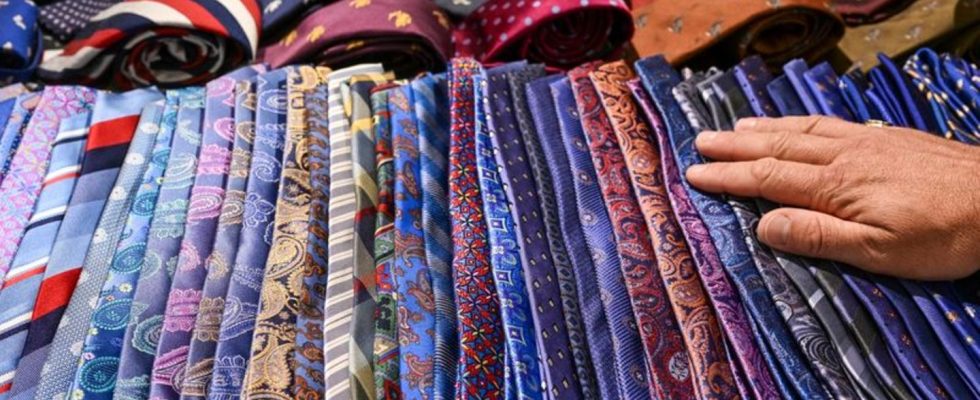Why is the tie called a tie? And what do prominent tie wearers like Guido Maria Kretschmer and Günther Jauch think about men’s special jewellery?
For centuries it was a popular fashion accessory and status symbol. But in the meantime, the tie seems to be gradually disappearing from wardrobes. Politics and the financial world have already said goodbye to her in many cases. The modern man prefers to be casual: an open shirt and jeans instead of a suit and tie. Was that it?
The idea of artistically tying a piece of cloth around your neck is more than 2000 years old. Even Chinese soldiers in the 3rd century BC wore a kind of tie. Roman soldiers also used a scarf to protect their necks: not only from the cold, but also from the sharp edges of their armour. However, this fashion was largely lost in the Middle Ages. Except in one country: Croatia.
The tie was a fashion gamble
The German term “Krawatte” comes from the French word “Cravate”, an old term for “Croats”. During the Thirty Years’ War, Croatian cavalry units wore scarves. Their French comrades adopted this fashion and named the garment after the Croats.
And today? For a long time, the tie was the only leeway men were allowed in their strictly regulated business dress code, says Carl Tillessen from the German Fashion Institute (DMI). “Here “man” could flash his private self and show taste, courage, style and sophistication.”
But that was once. The French fashion designer Hedi Slimane helped the tie to make a comeback in the noughties – and at the same time dealt it a deathblow, says DMI chief analyst Tillessen. “By making varsity black ties popular, he made the tie cool and robbed it of its charm.”
News anchor topless
Eventful history or not, the tie is no longer a must. Previously unthinkable: now you can even see men topless, i.e. without a tie, on news programs. At least for the former Tagesthemen moderator Ulrich Wickert, this is still a no-go: “I associate a tie with the respect that I show my counterpart,” says the 80-year-old. In a very hot summer, he also moderated the daily topics without a jacket, but never without a tie. “That forbade me out of respect for the spectators.”
Wickert was named Tie Man of the Year by the DMI a few years ago. Like ex-boxing world champion Henry Maske (59), for whom the tie is still important: “If I spot a tie that I find appealing, I’ll buy it,” he says. “There is always a reason to wear them.”
Fashion designer and “Shopping Queen” juror Guido Maria Kretschmer (58) sees the tie as an exceptional article, as “the last relic from a completely different time”. The tie looks good on many, even in old age. He himself has many ties in the closet. “I hardly ever wear it anymore, which is a shame, and I hope it never gets completely lost.”
Where’s the Tie Man of the Year Gone?
One of the best-known tie wearers in the country is moderator Günther Jauch (67). But except for his show “Who Wants To Be A Millionaire,” he hardly ever wears a tie, he says. “In principle, I now consider ties to be dispensable.”
When he was named Tie Man of the Year, he was promised to provide him with ties for five years. However, one of them never reached him, according to Jauch. “Perhaps an indication that the obligation to wear a tie is becoming more and more out of fashion.” According to DMI, ties are not part of the award. Perhaps there was an agreement between Jauch and a tie manufacturer. “Unfortunate if it wasn’t implemented.”
In 2019, the last tie man of the year was honored: trumpeter Till Brönner. In the pandemic years, the industry did not feel like celebrating. “But of course that can change again at any time,” it says when asked.
The pandemic finished the tie
So it’s not the end of the man’s special jewelry after all? The figures from major fashion brands say otherwise. Hugo Boss says that the production of ties has declined, especially in the past five years. The fashion house C&A has seen sales of ties and bow ties fall by around 70 percent since 2011.
One possible reason: “Dress codes are loosening up,” says Tillessen. The pandemic has accelerated this development enormously. Up until the lockdown, advocates of a stricter dress code had argued that ties were a sign of respect. “Now we’ve met in video calls in sweatshirts and found that respect doesn’t suffer.”
In order to save the tie, it has to go back to its origins – when it was a colorful scarf that people tied around their necks as an expression of joie de vivre, Tillessen believes. “If she were to return to that origin, she could certainly delay her complete disappearance for quite some time.”

